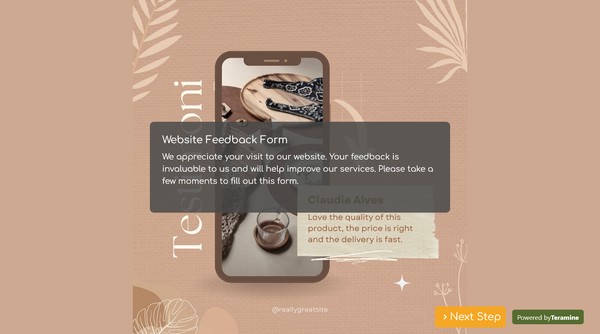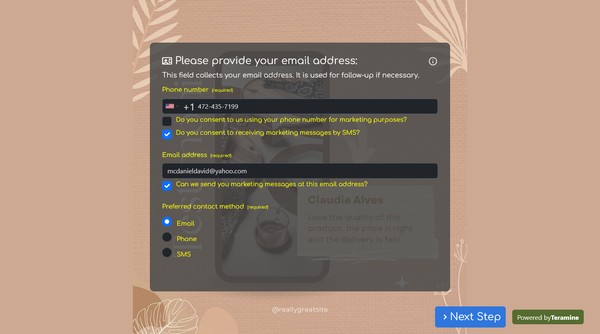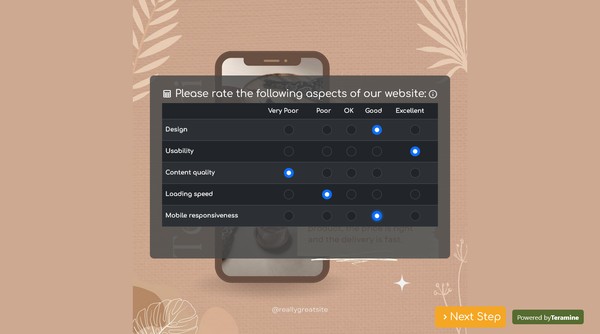Website Feedback Form

Harness the Power of User Insights!
Why Install Our Website Feedback Form?
In today's digital age, understanding your visitors' experiences and preferences is key to creating a user-friendly and engaging online presence. Our Website Feedback Form is designed to collect valuable insights directly from your users, providing several compelling advantages:
Enhance User Experience:
- Gain actionable feedback on website design, usability, content, and functionality to tailor your site to meet users' needs.
Identify Pain Points:
- Quickly discover and address issues such as broken links or navigation difficulties to maintain a seamless user journey.
Drive Content Improvement:
- Understand the relevance and usefulness of your content to continually provide valuable and engaging material to your audience.
Boost Engagement:
- Foster a responsive and adaptive website that encourages repeat visits and longer engagement times.
Make Data-Driven Decisions:
- Collect demographic information and other relevant data to better understand your audience and make informed decisions.
Encourage User Participation:
- Show your audience that their opinions matter, building trust and loyalty by proactively seeking their input.
Install our Website Feedback Form today on your website or social media platforms to stay attuned to your users' needs and drive continuous improvement. Your visitors will appreciate the opportunity to be heard, and you'll gain the insights needed to elevate your online presence.
Transform Insights into Actionable Improvements!











Website Feedback Form FAQs
A Website Feedback Form is a structured tool designed to solicit input from users regarding their experience on a website. This form typically includes a series of questions, both open-ended and multiple-choice, aimed at gathering insights into user satisfaction, navigation ease, content relevance, and any technical issues encountered.
Businesses often utilize feedback forms to identify areas for improvement, assess user engagement, and enhance overall site performance. By analyzing the data collected through these forms, organizations can make informed decisions that lead to a more user-friendly website, ultimately driving higher levels of customer satisfaction and loyalty.
In summary, a Website Feedback Form serves as a vital asset for continuous improvement and alignment with user expectations in a digital landscape.
A Website Feedback Form is essential for gathering insights from users regarding their experience, usability, and overall satisfaction with the site. Below are key components that should be included in an effective feedback form:
Contact Information (Optional):
- Name
- Email Address
- Phone Number
User Experience Questions:
- Overall satisfaction rating (e.g., a scale of 1 to 5)
- Specific usability questions (e.g., "How easy was it to navigate the site?")
- Clarity of content (e.g., "Did you find the content clear and helpful?")
Specific Feedback Areas:
- Design/Layout
- Speed/Performance
- Content Quality
- Accessibility
Open-Ended Questions:
- "What did you like most about the website?"
- "What improvements would you suggest?"
Feature Request Section:
- An area where users can suggest additional features or services they would like to see.
Bug/Error Reporting:
- Option to report any technical issues encountered while using the site.
General Comments:
- An open field for any other thoughts or feedback the user may wish to share.
Demographic Information (Optional):
- Age range
- Location
- User type (e.g., new visitor, returning visitor)
Consent Checkbox:
- To confirm whether the user agrees to have their feedback used for analysis and improvements.
Submit Button:
- A clear and accessible button to submit the feedback.
Including these elements in your Website Feedback Form will facilitate valuable input from users and help enhance the overall performance and user experience of the website.
Utilizing a website feedback form offers several strategic advantages for businesses, which can enhance overall performance and customer satisfaction. Here are some key benefits:
Improved Customer Insights: Feedback forms provide direct insights into customer preferences, expectations, and pain points. This information is invaluable for understanding user behavior and can guide future product or service development.
Enhanced User Experience: By gathering feedback, businesses can identify usability issues or obstacles on their websites, allowing for necessary adjustments that lead to a more streamlined and enjoyable user experience.
Increased Engagement: Encouraging visitors to share their opinions fosters a sense of community and engagement, making them feel valued. This can lead to higher customer loyalty and repeat business.
Data-Driven Decision Making: The quantitative and qualitative data collected through feedback forms can inform strategic decisions, ensuring that improvements align with customer needs and market trends.
Benchmarking and Tracking Progress: Regularly analyzing feedback allows businesses to benchmark their performance over time. This can help in tracking the effectiveness of changes made to the website and understanding long-term trends.
Identifying Areas for Improvement: Feedback forms can highlight specific issues or features that require attention, enabling targeted enhancements that can lead to increased conversion rates.
Responding to Customer Concerns: A feedback mechanism provides an avenue for customers to voice their concerns, enabling businesses to address issues promptly, thereby fostering trust and enhancing customer relationships.
Competitive Advantage: Businesses that actively solicit and act on feedback demonstrate a commitment to customer satisfaction, which can differentiate them from competitors in the marketplace.
Cost-Effective Methodology: Implementing a feedback form is typically low-cost compared to other customer research methods, making it an efficient tool for gathering valuable information.
Flexible and Customizable: Feedback forms can be easily tailored to align with specific business objectives, target customer segments, and the type of information desired.
In summary, a website feedback form is a critical tool for businesses striving to refine their offerings, enhance customer satisfaction, and maintain a competitive edge in the market. By actively seeking and utilizing customer input, companies can cultivate a responsive and customer-centric approach that drives long-term success.
Yes. We take the security of your data very seriously. We have built our application in compliance with the latest security standards. Your data is locked down with access allowed only after strict security checks. In addition, we use the latest SSL encryption standards to protect your data in transit from our servers to your device. You can also protect your forms by using our captcha widgets to prevent spam.'









